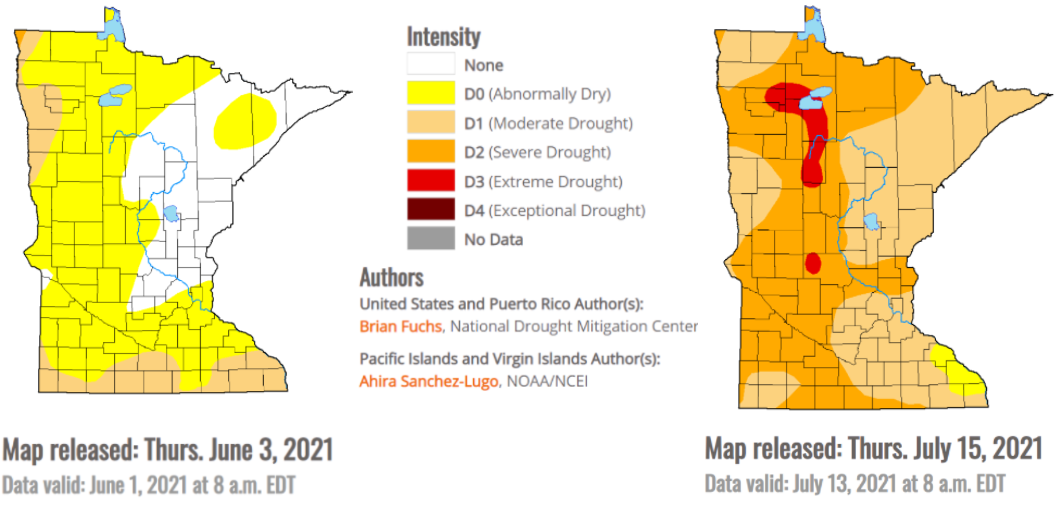By Shane Evans
For those of you who don't know, the Irrigation Association has deemed July as Smart Irrigation Month. According to their website, “Smart Irrigation Month is an Irrigation Association initiative celebrated throughout July to promote the social, economic and environmental benefits of efficient irrigation technologies, products and services in landscape, turf and agricultural irrigation” (Irrigation Association, 2020).
In a previous article I addressed the issue of drought within Minnesota. As such I wanted to give an update on Minnesota drought conditions and promote the benefits of implementing these smart irrigation technologies.
As the old saying goes, “a picture is worth a thousand words”. As you compare the two images in Figure 1, it is easy to recognize the increased drought intensity that has occurred within the state of Minnesota over the last ~40 days. If you like numbers, the image from June 1st represents approximately 750,000 Minnesotans who were experiencing some form of drought. The image from July 13th represents over 5 million Minnesotans who are currently experiencing drought conditions.
The Benefits of Smart Irrigation Technologies
To begin, I wanted to briefly mention a few of the smart technologies that currently exist for irrigation controllers. If you would like to learn a little more, you can follow this link to an article from the University Extension Yard and Garden News: Technology to help your sprinkler system for this upcoming year.
- Rain sensor - As rain falls, the cork discs within the sensor begin to swell. This swelling interrupts communication for the irrigation controller and cancels any irrigation events until the discs dry out and shrink.
- Soil moisture sensors - A soil moisture sensor can tell you how “wet” the soil beneath your lawn is. Based on a previously set moisture level, irrigation events are cancelled until the sensor detects the soil is “dry” and below the set moisture threshold.
- Wi-Fi enabled irrigation controller - These controllers are often called “smart” controllers and can tap into local weather data from surrounding weather stations in the area.
These irrigation technologies, when properly installed, have been shown to apply less water than a traditional irrigation controller. What people may forget is they work under a variety of weather conditions. Each type of technology is designed to help the homeowner apply the correct amount of water necessary for a lawn. This means they will stop the sprinkler system from running if it is raining and during periods of drought, like we are currently experiencing, it will help to apply the appropriate amount of water to your lawn. If you would like to learn more about how much water a typical lawn needs please see these articles.
Water Wisely: Start in your own backyard
Water-saving strategies for home lawns
You may, or may not, have an irrigation system which can take advantage of these smart technologies I have mentioned, but what you do have is a desire to learn and to make a difference. From this post alone, you can see the University supplies a lot of information regarding efficient irrigation practices. You also just learned, the Irrigation Association dedicates a whole month to the cause! The sad reality however is that information is only useful when citizens put it into practice. To celebrate Smart Irrigation Month please share this with someone, and let's hope our communal mindset regarding irrigation practices can become a little bit better.
